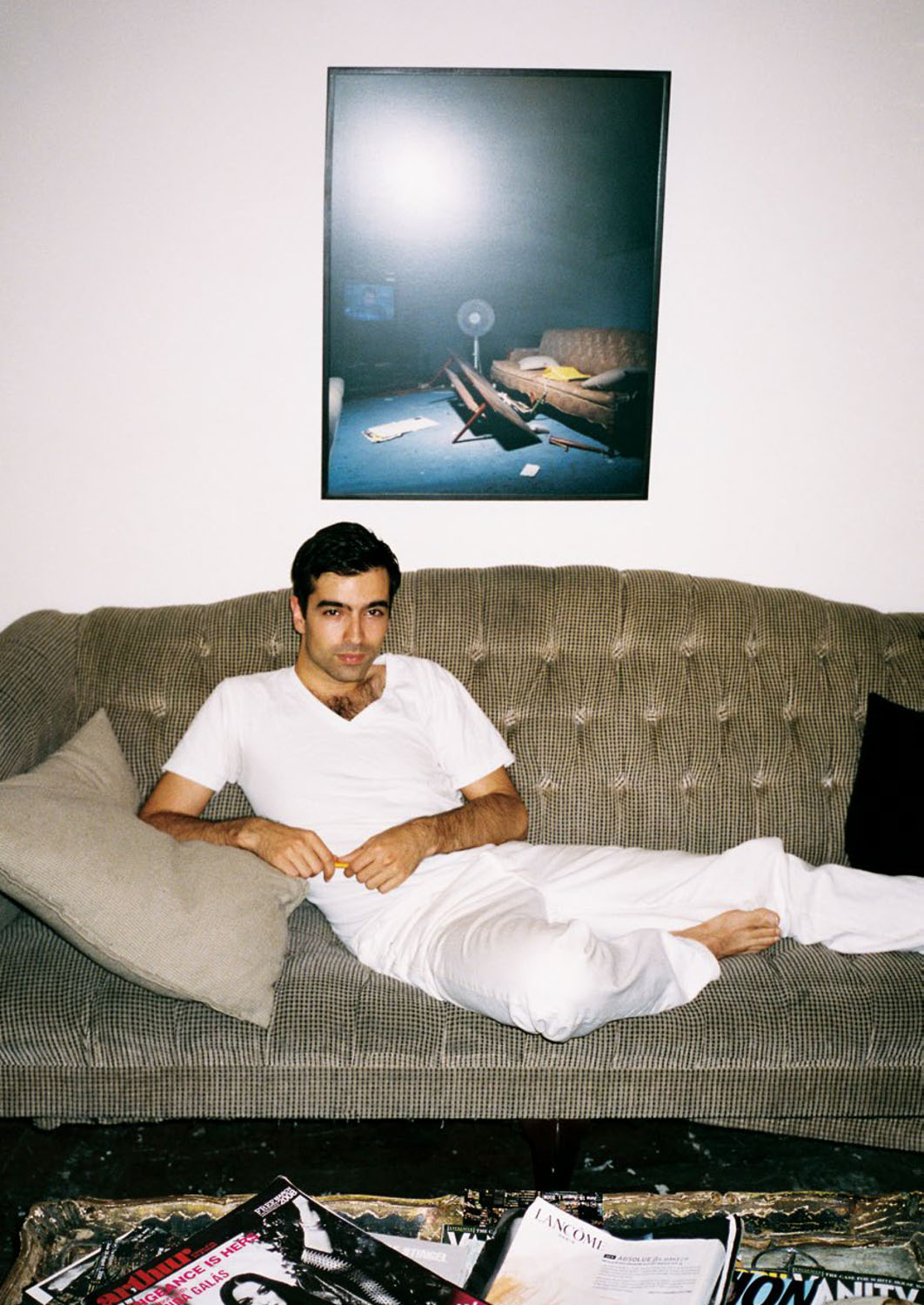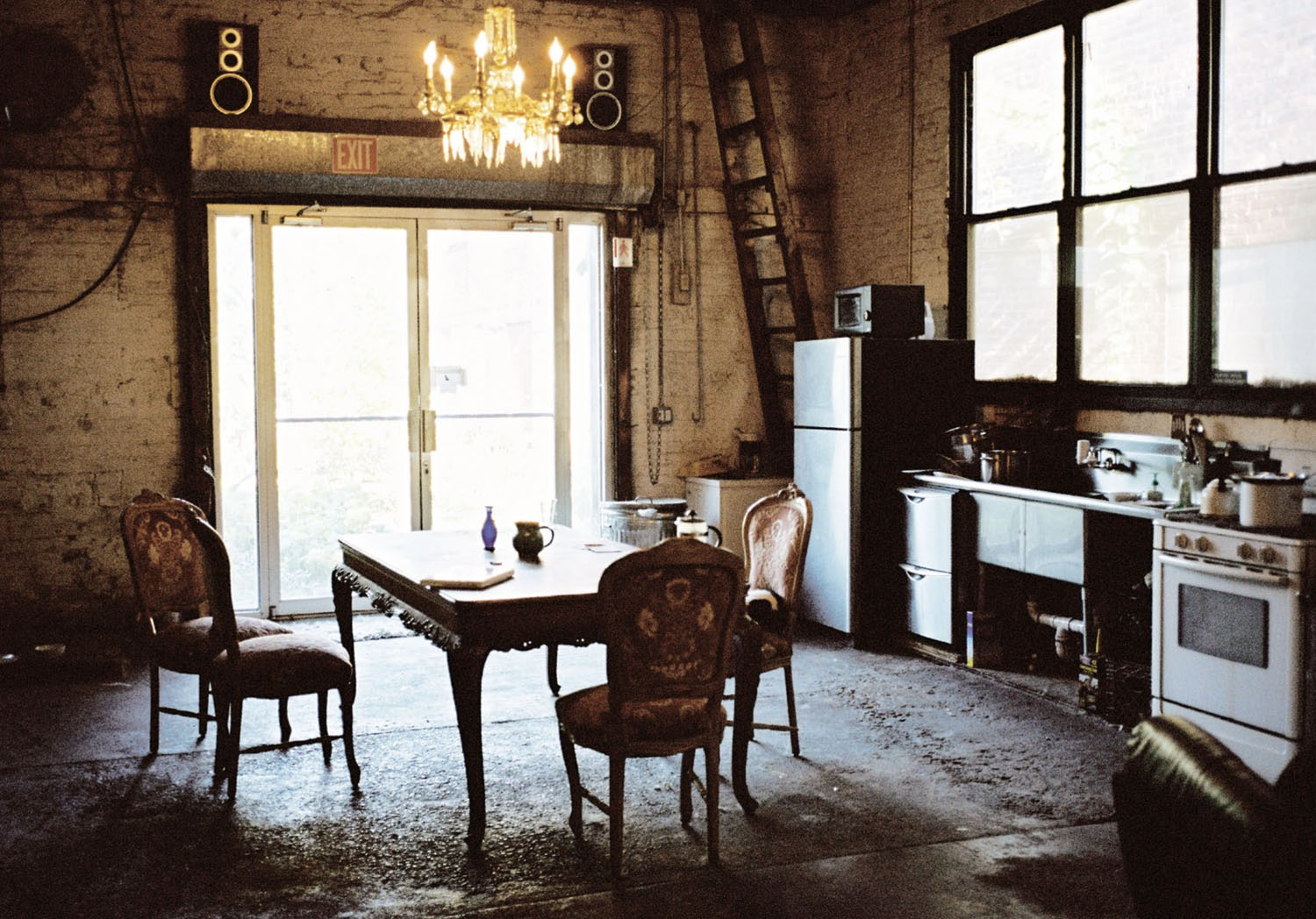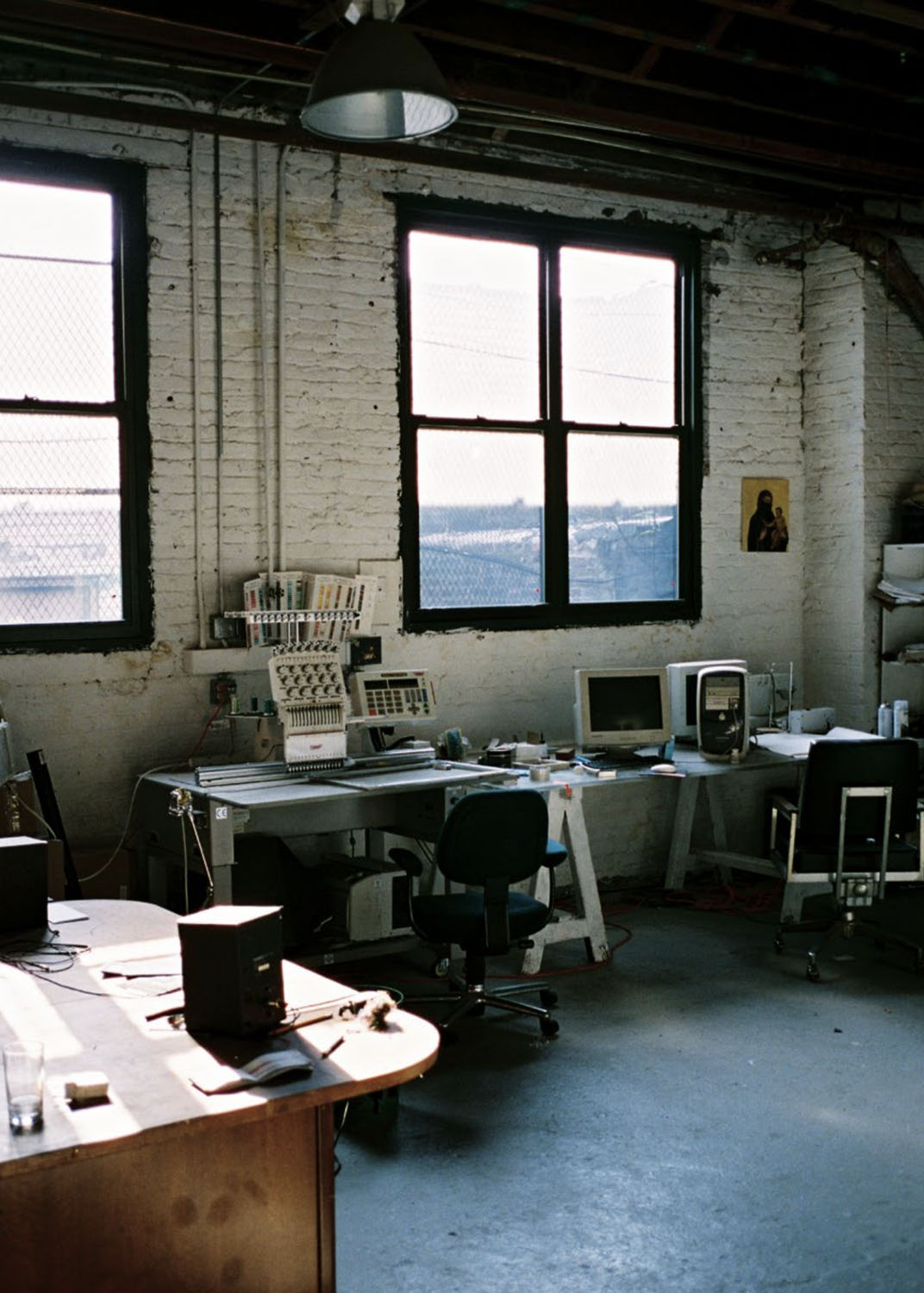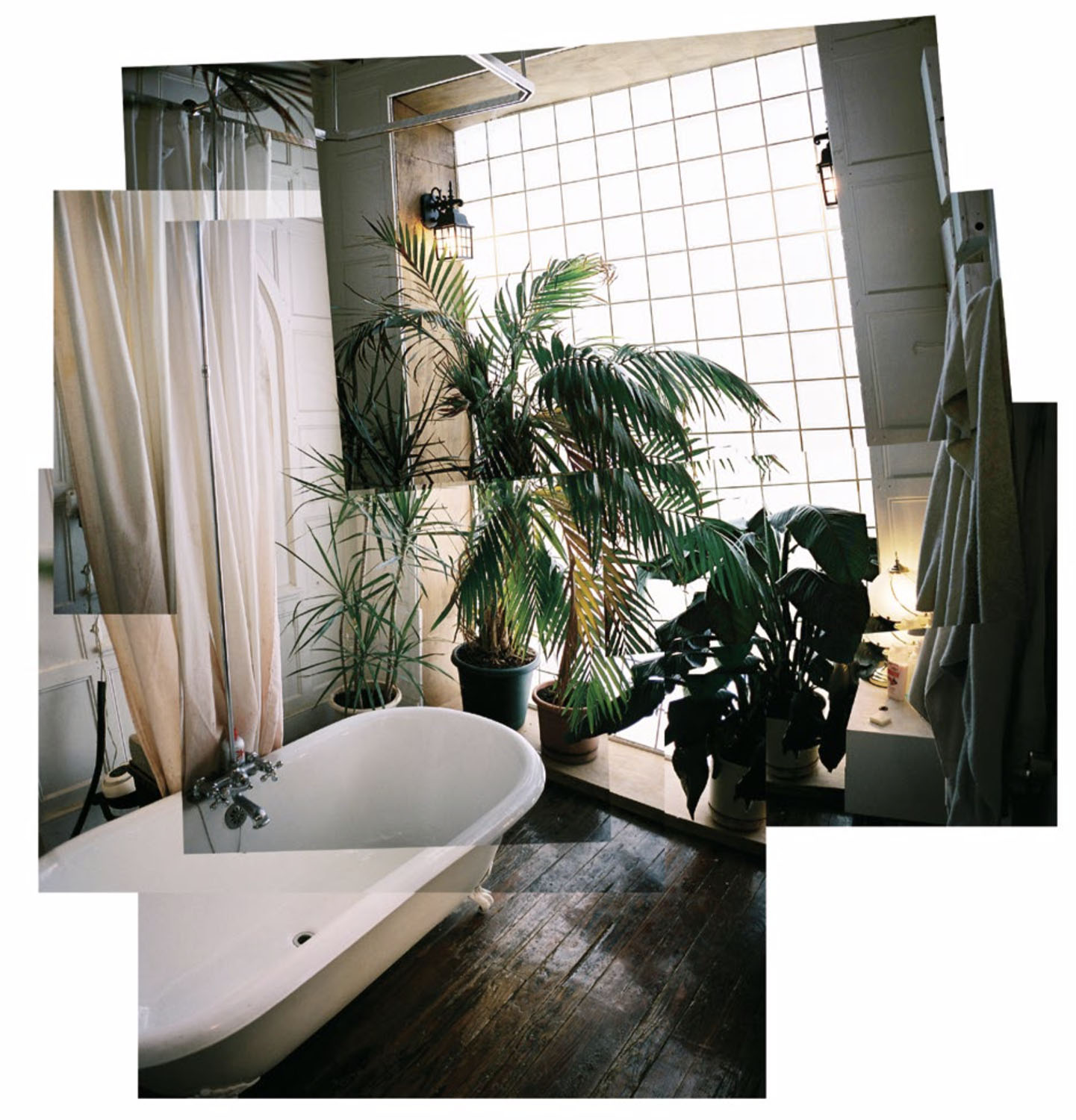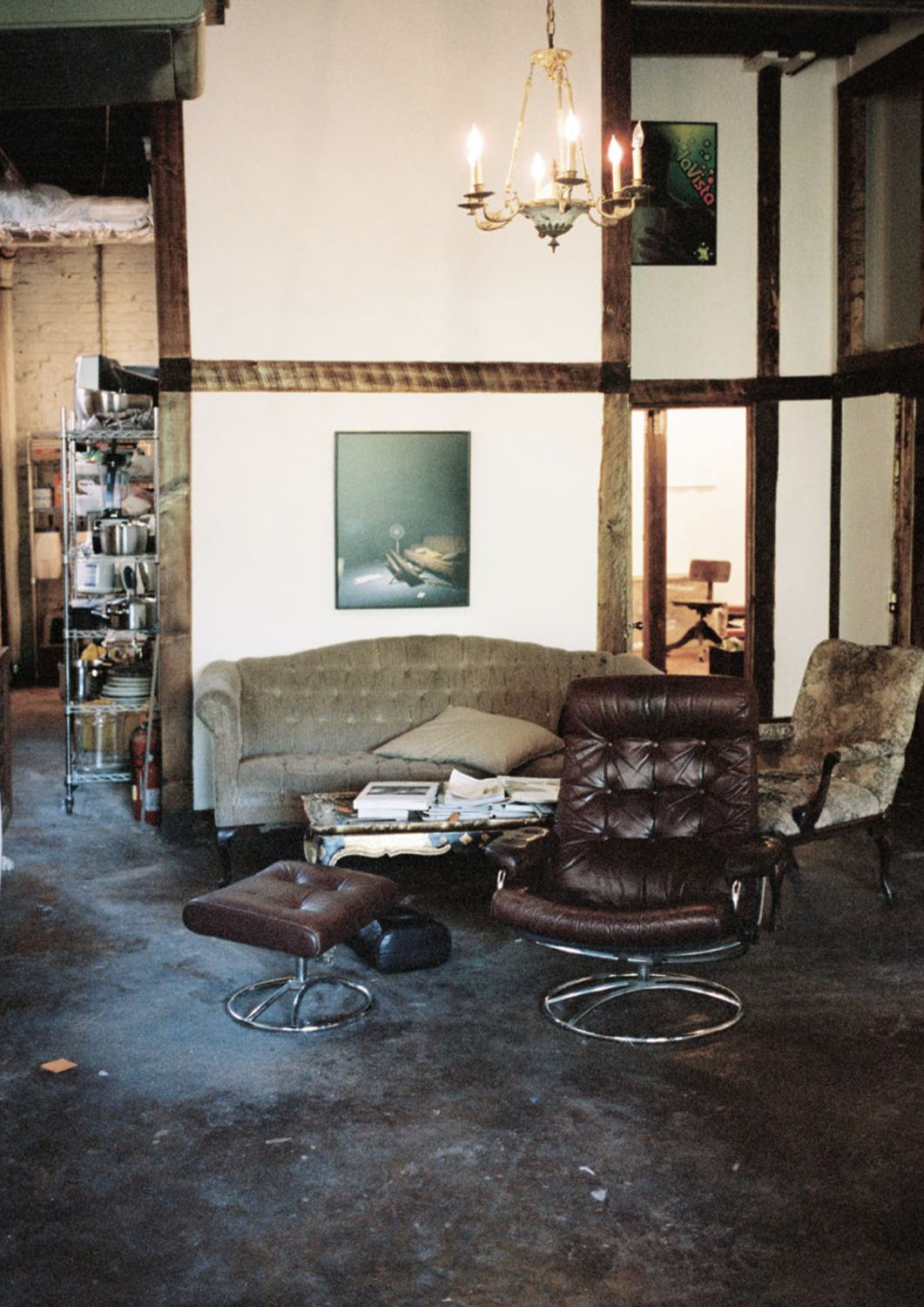ALEXANDRE SINGH
Text by Michael Bullock
Interview by Lafawndah
Photography by Nacho Alegre
Apartamento 3, 2009
On the outskirts of Brooklyn you find a world of enormous factory buildings, which some old timers refer to as the East Williamsburg Industrial Park. There is a handful of companies here still in operation but most buildings have far out lived their original use. The streets are empty and quiet and the feeling is isolated, a touch lonely. For most people this part of Brooklyn would be inhabitable, but when Alexandre Singh moved here from London he thought it was a great place to make his home.
In 2005 he bought one of these buildings and transformed the raw space, guided by childhood fantasies of the mythic 80’s New York art world. The façade of Alexandre’s home looks like every other one in the area, made of brick with a 20 foot high metal roll-up garage door that opens into a loading dock. Once inside, you are greeted by a long white hallway that cuts through the middle of the space. On both sides are enviously spacious studios. At the end of this great hall you find yourself at a heavy wooden door. You pull on a lion’s head that serves as a doorknob, and here you are in Mr. Singh’s Castle.
Here Alexandre has done what artists do at their best: completely erase your own context and bring you into a world of their own making. The feature that separates this space from every other artist loft is the Tudor-style, post-and-beam village. Five tiny duplexes serve as private living quarters for Singh, his roommates, collaborators and guests. These structures surround the kitchen/living room area and separate it from the studio space. Transplanting this 16th century English building technique into modern day Brooklyn is confusing and exciting, it’s also quite comfortable; more like a British country home than the urban residence of a young artist. Alexandrea’s latest project is based on a contemporary Gothic novel which he wrote himself. Wandering around his home, that makes perfect sense.
There is something I like about your place, because it has this castle feeling... it looks a bit decadent. What do you think?
Oh yeah, totally. When I was really young, before I was in high school, I loved watching films about the art world. They were always such unrealistic, romanticized New York stories. I loved the Basquiat film which was directed by Julian Schnabel, and features him in his studio. I don’t know if it was his house or if it was an exaggeration of his house. I haven’t seen that movie in many years but I remember the ceiling being 14 feet tall and he was listening to his opera very loudly, while eating bowls of pasta in his studio. It felt very old fashioned and grandiose. It has a decadent luxury to it and I thought, oh, one day I have to live like that!
So how did you go about turning this warehouse into your NY art world fantasy? What was it like when you bought it?
I bought it in the winter of 2005. The building has a long history as every building in Brooklyn does. I love going to people’s houses and they tell me, “Oh it used to be a biscuit factory.” There is a sort of gentrified pride in the obscure interesting industrial usage of the building before you move into it. Mine was originally a company that made parts for tanks during the Second World War and after that for a long time it was a furniture-manufacturing factory.
When you moved did you have a clear vision for how it looks now? Or did it happen little by little?
Little by little. I am still adjusting to it. And you can probably see on the pictures that the living area, it’s like a house from Les Landes, in the South of France, in the sense it has exposed beams with plaster wall between them. I hated so many warehouse conversions that you see in America, Berlin, and London where people use drywall and it ends up looking so generic and closed up. You have a huge building and it ends up being compartmentalized, so I worked at keeping it an open feeling.
Is this the first time you are living in your own design? It’s kind of an extreme design.
It is the first time, but I got used to it quickly. I can’t see it with other people’s eyes anymore.
How long did the first round of major construction take?
Actually I was cursing myself at the end because I thought it would take two weeks but it took 3 months. But what’s great about this construction, it’s very easy for me to knock down a wall because the beams are very stable so the sheet rock stays in. It’s pretty flexible. The building is always changing and it’s becoming more domesticated and more interesting.
Is there a master plan of where it’s headed?
It’s all very organic but I get to perfect things over time. Like, I really want that light switch to be here, or this door should open inwards. I can correct my mistakes. I like that a lot. Most of people can’t do that to their houses. The great thing about an industrial space is that it’s bear bones. When I first moved to the U.S, I had no idea how a building was put together because in Europe buildings are so old. If you knock a wall down you may have no idea what’s going to be inside. Coming to America and going to places like Home Depot you realize, you can put up a wall in an hour and you see where pipes go. It’s customizable, and changeable like everything in America. American houses are put together in a really shoddy manner, but it’s also very democratic because it’s easy to change. It’s amazing the kind of projects people do themselves here that in Europe you would never think of doing yourself.
What about the furniture?
I love that it’s not modern like most industrial spaces. Most of our furniture comes from my next door neighbor, this Lebanese man who owns a furniture factory. Quiet often, he throws stuff out because it’s too expensive to repair it. So we salvage it and we bring it in the house and we paint it. It’s like orphans...like dogs at the pound. We rescue these poor pieces of furniture.
What was your house like as a kid did that influence this place?
I grew up mostly in Manchester in the typical ugly suburban sprawl of concrete houses. It was really depressing, ugly 70’s carpets, a lot of couches, but my grand parents lived in Mont de Marson in the South of France. Their house was very, very dark and filled with very old furniture, heavy chandeliers and stuff they collected from traveling to places, finding things like African effigies. For years I would have nightmares and dreams about being in that house. Now, I really miss that kind of heaviness; it’s not really a specific time period, so let’s call it a Victorian-esque aesthetic.
Do you feel your place is more American or European?
It is a mixture. You have to remember that even, for example, in the Victorian era, people would have 17th-century reproduction furniture; at the time there wasn’t a unified aesthetic, nobody lived like that. The same is true in modern houses, it’s a mishmash of eras and styles.
You mentioned you thought of it as New England, which I guess is a mixture of both. This style you find much more upstate then in the city.
I do think of the house as being upstate. It feels secluded. I need that psychological space, I couldn’t handle living in New York City otherwise. I like that. It allows you to be very introspective and introverted and then you walk 5 minutes, you’re at the subway, in the heart of civilization.
Do you feel at home here?
Oh yes! Absolutely! It’s totally natural. Yeah, even if at first it came from a picture in my mind of how I would like to live, you grow into that. Maybe everybody goes through life like that. You have a sort of vague image of what you would like to be like and you grow towards that. You may not become exactly that person but there is an artifice as to how your personality, your looks, your interest and the environment you build around yourself develop. I’m not a subscriber to the idea that there is any truth whatsoever as to authenticity in terms of a person’s personality. I think you grow into it.
Was New York necessary for you to achieve this idea of yourself?
It is hard to say because it’s a different moment of my life. London is a city that eats it young. People complain about New York being expensive. London is exorbitant. I mean I couldn’t live in London and try to do the kind of things I am to doing here. It’s hard to break in and get your first steps. Whereas in NY people are interested, curious, accommodating. You can do things on the cheap. It’s amazing how you can get interns and grants. You could put on the most amazing production that would be 20 times the cost in Europe. I like that a lot.
So have you become a New Yorker?
It is funny because I stopped thinking about the fact that I live in NY - I’m not really aware of it anymore. Maybe you’ve experienced this. The very first few days moved I was laughing because everybody sounds like they are in a film, they all have American accents. It sounds so contrived. I felt, the moment I stopped listening they would break back into their normal voices. And to some extent, you start to become unaware of people’s accent, you become unaware of New York’s character, you just take it for granted. And in a sense it’s slightly characterless but what’s great about New York, it’s Europe on steroids in a sense. All the nations are here together. You are not thinking of who someone is or where they are from, it just works in. That’s unlike anywhere in the world. The Apple store is open 24 hours a day; you can get anything you want. People work on Saturdays and Sundays, obviously people in France would be appalled if their society would operate that way but it’s amazing. You can do the kind of things that would be out of reach for younger artists in another places.
I see a relationship between your work, or at least with the trilogy you’re working on, and your house. What do you think?
How did you see that?
Well, you tell stories in your work and that’s what your place feels like. You know sometimes you enter a space and it’s mute and sometimes you enter a space and everywhere you look, every corner tell you a different history. I felt your house was a setting for a play written by Theophile Gautier or Edgar Allen Poe, you know? Very theatrical.
I am quite an antiquarian. My favorite artists are rather conservative antiquarian figures: H.P. Lovecraft (who was obsessed with the past), the history of Providence, or Mikhail Bulgakov, who rejected all the contemporary Russian society and who was immersed in the music of Gounod.
You fancy yourself as this reclusive, introverted artist but yet you lived here with 10 people at certain points, right?
It is funny because you think it’s completely normal for people to play music until 9 in the morning, staying up all night in their studios and it is just a mess everywhere. It was great for a while, it was really la vie de boheme. It was a great way to move to New York. Its something I am glad I did but now that I am working so much on my practice it became difficult. I was just coming home after international flights and non-stop installing for 2 weeks and there would be nothing in the fridge. The fact you couldn’t leave anything out because you knew someone would eat it or take it. I ended up being a dad and having to look after people.
So you kicked everybody out?
Yeah. It’s changing now because now I’m inviting people to come and stay for short amounts of time. I can really be the generous host, which I love. When they are guests they are so sweet. I much prefer that relationship. It’s nice and you still get that creative dialogue. When I can, I like to help support the people I think deserve it.
So I guess you don’t have big parties any more.
I host dinners. I told you, I am an old man.
